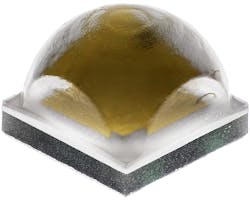Cree launches 200-lm/W, 1226-lm discrete LED for directional SSL
Cree has announced the new XLamp XP-L LED family in a 3.45×3.45-mm package promising that what the company calls a member of its high-density grouping of LEDs will provide a drop-in upgrade for lighting products that use the prior XP-G/G2 LEDs. The new LEDs reach efficacy levels as high as 200 lm/W in cool white, at a modest 350 mA of drive current, while solid-state lighting (SSL) product designs can drive the LEDs at levels to 3A. Indeed, the maximum 10W LEDs are based on a discrete die and now far exceed what would conventionally be considered a high-power LED.
In recent announcements, Cree has stressed a metric called optical control factor (OCF) that characterizes lumen output relative to light-emitting surface (LES) area. The company introduced the OCF concept with the high-density chip-on-board (COB) LEDs announced in February. Subsequently, Cree subsequently touted OCF in the discrete XB-H LED that measures 2.5 mm per side. Those announcements along with the XP-L release are all part of what Cree calls it high-density offering -- LEDs that are especially applicable for directional lighting because it's easier in an SSL product to control the beam from a smaller source.
Cree compared the XP-L LEDs to existing XP-G2 LEDs in a prototypical 30-mm reflector lamp design that in all instances includes four LEDs connected in series. More LEDs in this case driven at a relatively lower current creates the best balance of lumen output and efficacy.
An SSL manufacturer can upgrade a design to the new LED and realize significant gains in light output and efficacy. The XP-G2 example delivers 912 lm at 75 lm/W when drive at 1A. The XP-L version delivers a 30% improvement in lumen output at 1188 lm, and slightly better than a 30% efficacy gain at 98 lm/W. Moreover, the new LEDs deliver a 31% improvement in center beam candle power (CBCP).
"We’re excited about the new XLamp XP-L LED because its next-level performance enables us to create the next generation of light output and efficacy for our directional lighting products," said Mike Joye, president, Auroralight. "Since XP-L uses the existing XP footprint, we can expand our product lineup quickly and without the burden of increased development time and cost that would be expected for such a significant performance enhancement."
Alternatively, a manufacturer could upgrade to the new LEDs, reduce drive current, and realize even greater efficacy while matching the lumen output of an earlier product. Indeed, Cree's comparison revealed that the XP-L LEDs driven at 700 mA can deliver 924 lm output at 111 lm/W.
Of course, the LEDs also offer the option of ramping driver current to push lumen output at lower efficacy levels. "We evaluated many high-power LEDs before deciding on Cree’s new high-density discrete LEDs," said Jason Gerard, group general manager for engineering at Gerard Lighting Group. "Cree’s high-density LEDs enable us to develop a core design that was not possible with previous LEDs for our given design targets. We’re excited that we can use the newest of Cree’s innovations to make our products stand apart from everyone else’s."
Cree will offer the XP-L LED family over the range of 2700K-8300K CCT. At the warmer end manufacturers can specify 90 CRI and at the cooler end a 70 CRI options is available. Most of the family is available at 80 CRI.
The XP-L is also considered a follow-on product to the XP-G2 in the eyes of the Energy Star program. That recognition means that SSL manufacturers can submit products based on the new LED for Energy Star certification after only 3000 hours of LM-80 testing.





